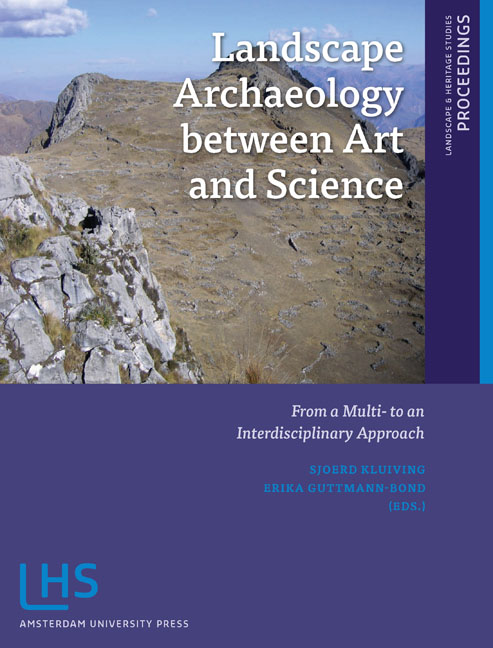Book contents
- Frontmatter
- Contents
- Preface
- Introduction: LAC2010: First International Landscape Archaeology Conference
- THEME 1 HOW DID LANDSCAPE CHANGE?
- THEME II IMPROVING TEMPORAL, CHRONOLOGICAL AND TRANSFORMATIONAL FRAMEWORKS
- THEME III LINKING LANDSCAPES OF LOWLANDS TO MOUNTAINOUS AREAS
- THEME IV APPLYING CONCEPTS OF SCALE
- THEME V NEW DIRECTIONS IN DIGITAL PROSPECTION AND MODELLING TECHNIQUES
- THEME VI HOW WILL LANDSCAPE ARCHAEOLOGY DEVELOP IN THE FUTURE?
- Miscellaneous Endmatter
3.1 - A Qualitative model for the Effect of Upstream land use on Downstream water Availability in a Western Andean valley, Southern Peru
Published online by Cambridge University Press: 21 January 2021
- Frontmatter
- Contents
- Preface
- Introduction: LAC2010: First International Landscape Archaeology Conference
- THEME 1 HOW DID LANDSCAPE CHANGE?
- THEME II IMPROVING TEMPORAL, CHRONOLOGICAL AND TRANSFORMATIONAL FRAMEWORKS
- THEME III LINKING LANDSCAPES OF LOWLANDS TO MOUNTAINOUS AREAS
- THEME IV APPLYING CONCEPTS OF SCALE
- THEME V NEW DIRECTIONS IN DIGITAL PROSPECTION AND MODELLING TECHNIQUES
- THEME VI HOW WILL LANDSCAPE ARCHAEOLOGY DEVELOP IN THE FUTURE?
- Miscellaneous Endmatter
Summary
ABSTRACT
The rise and decline of pre-Columbian cultures in coastal Peru has been the subject of numerous studies. Availability of and access to water have long been recognised as the key issues for the habitability of valley oases in the coastal desert where agriculture depends on seasonal river discharge from the Andes. In general, the reason for cultural changes has often been seen in ‘natural disasters’ or climatic changes. We propose an alternative qualitative model to explain changes of human-environment interactions in the region. This model focuses on patterns arising from the exploitation of and adaptation to the limited – but on the whole not necessarily declining – resources of water and arable land. Agriculture along the rivers of the Peruvian coastal desert was probably first practised in the wide, gently sloping lowland valley floor areas at the foot of the Andes, where large tracts of land can be irrigated with relatively low expenditure of labour. Subsequent expansion of agriculture necessitated the utilisation of progressively marginal areas along the upstream reaches of the rivers. While the spatially limited valley floor areas can to a certain extent be irrigated with short irrigation canals, irrigation of the steep valley slopes of upvalley areas requires the labour-intensive construction and maintenance of canals and terraced fields in difficult – and arguably less productive – terrain. Diversion of water onto up-valley terraced fields can be expected to have reduced water availability in the lowland valley floor fields. Thus, the adaptation to the constraints of one limited resource (irrigable land) may have led to a suboptimal exploitation of another limited resource (water), leading to an overall decline in agricultural productivity per unit of arable land. Such a feedback between land use and water availability is consistent with archaeological findings such as declining population density and increasing conflict during the Early Intermediate Period.
KEYWORDS
qualitative modelling, Palpa Valley (Peru), Nasca, irrigation, water management, early agricultural land use systems (2800-550 cal BP)
INTRODUCTION
The Palpa Valley, a river oasis at the foot of the Andes in the desert of coastal southern Peru (fig. 1), has been inhabited for at least 3500 years. Settlement was based on irrigation agriculture which by distributing sediment-laden river water to the fields has created thick accumulations of irragic anthrosol (Hesse & Baade 2009).
- Type
- Chapter
- Information
- Landscape Archaeology between Art and ScienceFrom a Multi- to an Interdisciplinary Approach, pp. 241 - 248Publisher: Amsterdam University PressPrint publication year: 2012



